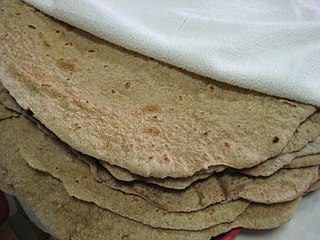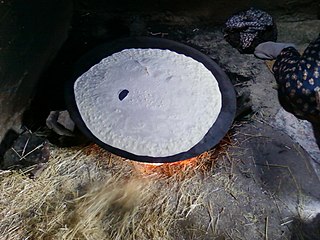
Chapati, also known as roti, rooti, rotee rotli, rotta, safati, shabaati, phulka, chapo, sada roti, poli, and roshi, is an unleavened flatbread originating from the Indian subcontinent and is a staple in India, Nepal, Bangladesh, Pakistan, Sri Lanka, the Arabian Peninsula, East Africa, and the Caribbean. Chapatis are made of whole-wheat flour known as atta, mixed into dough with water, oil (optional), and salt (optional) in a mixing utensil called a parat, and are cooked on a tava.

Roti is a round flatbread native to the Indian subcontinent. It is commonly consumed in many South Asian, Southeast Asian, Caribbean, and Southeast African countries.

Pakistani cuisine can be characterized as a blend of regional cooking styles and flavours from across South, Central and Western Asia. Pakistani cuisine is influenced by Persian and Arab cuisine. The cuisine of Pakistan also maintains certain Mughal influences within its recipes and cooking techniques. Pakistan's ethnic and cultural diversity, diverse climates, geographical environments, and availability of different produce lead to diverse regional cuisines.

Bhakri is a round flatbread often eaten in the cuisines of the states of Gujarat, Maharashtra, Rajasthan, and Karnataka in India. The bhakri prepared using jowar or bajra is coarser than a regular wheat chapati. Bhakri can be either soft or hard in texture, unlike khakhra in respect to hardness.

Unleavened bread is any of a wide variety of breads which are prepared without using rising agents such as yeast. Unleavened breads are generally flat breads; however, not all flat breads are unleavened. Unleavened breads, such as the tortilla and roti, are staple foods in Central America and South Asia, respectively. Unleavened sacramental bread plays a major part in Christian liturgy and Eucharistic theology.

A tava(h) / tawa(h) (mainly on the Indian subcontinent), saj (in Arabic), sac (in Turkish), and other variations and combinations thereof, is a metal-made cooking utensil. The tawa is round and can be flat, but more commonly has a curved profile, and while the concave side can be used as a wok or frying pan, the convex side is used for cooking flatbreads and pancakes.

A flatbread is bread made usually with flour; water, milk, yogurt, or other liquid; and salt, and then thoroughly rolled into flattened dough. Many flatbreads are unleavened, although some are leavened, such as pita bread.

Markook bread, also known as khubz ruqaq, shrak, khubz rqeeq, mashrooh, and saj bread, is a kind of Middle Eastern unleavened flatbread common in the Levant and the Arabian peninsula. It is baked on a convex metal griddle or in a tannour.

Indian breads are a wide variety of flatbreads and crêpes which are an integral part of Indian cuisine. Their variation reflects the diversity of Indian culture and food habits.
Roti is a flatbread originating from the Indian subcontinent.

The Miracle Chapati or Chapati Jesus is a chapati, or flat unleavened bread, roughly eight centimeters in diameter with, what believers claim, is an image of Christ miraculously burnt on it. The chapati was baked by Sheela Antony of Bangalore, India in early September 2002, enshrined in Bangalore, and visited by thousands of believers and curious onlookers.

Malaysian Indian cuisine, or the cooking of the ethnic Indian communities in Malaysia, consists of adaptations of authentic dishes from India, as well as original creations inspired by the diverse food culture of Malaysia. Because the vast majority of Malaysia's Indian community are of South Indian descent, and are mostly ethnic Tamils who are descendants of immigrants from a historical region which consists of the modern Indian state of Tamil Nadu and Sri Lanka's Northern Province, much of Malaysian Indian cuisine is predominantly South Indian inspired in character and taste. A typical Malaysian Indian dish is likely to be redolent with curry leaves, whole and powdered spice, and contains fresh coconut in various forms. Ghee is still widely used for cooking, although vegetable oils and refined palm oils are now commonplace in home kitchens. Before a meal it is customary to wash hands as cutlery is often not used while eating, with the exception of a serving spoon for each respective dish.

Paratha is a flatbread native to the Indian subcontinent, with earliest reference mentioned in early medieval Sanskrit, India; prevalent throughout the modern-day nations of India, Sri Lanka, Pakistan, Nepal, Bangladesh, Maldives, Afghanistan, Myanmar, Malaysia, Singapore, Thailand, Mauritius, Fiji, Guyana, Suriname, and Trinidad and Tobago where wheat is the traditional staple. It is one of the most popular flatbreads in the Indian subcontinent and the Middle East. Paratha is an amalgamation of the words parat and atta, which literally means layers of cooked dough. Alternative spellings and names include parantha, parauntha, prontha, parontay, paronthi (Punjabi), porota, paratha, palata, porotha, forota, farata, prata, paratha, buss-up shut, oil roti and roti canai in Malaysia and Indonesia.

Bread has a significance beyond mere nutrition in many cultures in the Western world and Asia because of its history and contemporary importance. Bread is also significant in Christianity as one of the elements of the Eucharist; see sacramental bread. The word companion comes from Latin com- "with" + panis "bread".

Thepla is a soft Indian flatbread typical of Gujarati cuisine While extremely popular across Gujarat, it is especially common amongst the Jain community.

Saj bread or tava bread is unleavened flatbread in Middle Eastern and South Asian cuisines baked on a metal griddle, called saj in Arabic and tava in the Indian subcontinent.

Indian Indonesian cuisine is characterized by the mixture of Indian cuisine with local Indonesian-style. This cuisine consists of adaptations of authentic dishes from India, as well as original creations inspired by the diverse food culture of Indonesia. Indian influence can be observed in Indonesia as early as the 4th century. Following the spread of Islam to Indonesia and trading, Muslim Indian as well as Arab influences made their way into Indonesian cuisine. Examples include Indian biryani, murtabak, curry and paratha that influenced Acehnese, Minangkabau, Malay, Palembangese, Betawi and Javanese cuisine.
Cuisines and food of the Indian state of Haryana is known to be simple. People of the state prefer their food to be made with fresh ingredients and through simple recipes. Roti is a staple food in Haryana which is made from a variety of grains and flours. Since Haryana is rich with agriculture and cattle, the use of dairy products is abundant in their food. Many households churn out fresh butter from milk and use it as opposed to the butter available in the markets. Lassi is a popular and staple drink in Haryana. The food in Haryana finds a lot of similarities with its neighboring states Punjab and Rajasthan.
Consumption of non-vegetarian food is generally avoided in the state and sometimes is even considered a taboo among the rural population.















